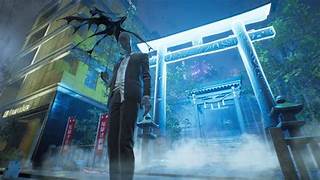GHOST TOKIYO WIRE
Ghostwire: Tokyo - A Comprehensive Overview
"Ghostwire: Tokyo" is an action-adventure game developed by Tango Gameworks and published by Bethesda Softworks. Released in March 2022, the game quickly gained attention for its unique blend of supernatural elements, action-packed gameplay, and the eerie, meticulously crafted representation of Tokyo. Directed by Kenji Kimura, with legendary game designer Shinji Mikami involved in its production, "Ghostwire: Tokyo" stands out in the gaming landscape for its innovative approach to storytelling and gameplay.
Storyline and Setting
"Ghostwire: Tokyo" is set in a modern-day Tokyo that has been overrun by supernatural forces. The game's story kicks off with a mysterious event that causes the city's population to vanish almost instantaneously. The protagonist, Akito, survives this phenomenon and soon finds himself bonded with a powerful spectral entity named KK. Together, they must navigate the now ghost-infested city, uncover the truth behind the mass disappearance, and confront the sinister Hannya, a masked antagonist orchestrating the chaos.
The game's narrative is deeply rooted in Japanese folklore and urban legends, which adds a rich layer of cultural authenticity. Players encounter various yokai (traditional Japanese spirits and demons) and other supernatural beings as they explore the hauntingly deserted streets of Tokyo. This blend of folklore with modern horror creates an atmosphere that is both intriguing and unsettling.
Gameplay Mechanics
"Ghostwire: Tokyo" offers a first-person perspective, allowing players to fully immerse themselves in the game's eerie environment. The gameplay primarily revolves around combat, exploration, and puzzle-solving. Here are some key aspects:
Combat
Combat in "Ghostwire: Tokyo" is distinctive, incorporating a combination of traditional weaponry and ethereal abilities. Akito can wield various elemental powers (wind, fire, and water) to combat the spirits. These powers are executed through hand gestures, mimicking real-life Kuji-kiri (a series of hand movements used in esoteric Japanese Buddhism). The game also features a bow and arrow for ranged attacks and talismans for defensive maneuvers.
Exploration
The open-world design of Tokyo is one of the game's highlights. Players can traverse the city's iconic districts, from Shibuya's bustling streets to the serene parks and shrines. Despite the supernatural occurrences, the city retains its realistic architecture and layout, creating an immersive experience. Vertical exploration is also a key element, with players able to climb buildings and glide across rooftops using their spectral abilities.
Puzzle-Solving
Puzzles in "Ghostwire: Tokyo" are designed to challenge the player's intellect and understanding of the supernatural world. These puzzles often involve purifying corrupted Torii gates, finding and returning lost spirits, and using spectral vision to uncover hidden objects or clues.
Visuals and Atmosphere
"Ghostwire: Tokyo" boasts stunning visuals that capture both the beauty and eeriness of Tokyo. The game's art direction seamlessly blends the neon-lit urban landscape with traditional Japanese aesthetics. The attention to detail is remarkable, with every corner of the city designed to enhance the atmospheric tension. The spectral entities and yokai are creatively designed, each reflecting their origins in Japanese mythology while also possessing a unique twist to fit the game's horror theme.
The game's atmosphere is further amplified by its sound design. The ambient sounds of the deserted city, combined with the chilling noises of lurking spirits, create a constant sense of unease. The soundtrack, composed by Masatoshi Yanagi and Reo Uratani, complements the gameplay with its haunting melodies and intense battle music.
Technical Specifications and System Requirements
To fully experience the haunting beauty and intricate gameplay of "Ghostwire: Tokyo," it's important to ensure your system meets the necessary requirements. Below are the minimum and recommended system requirements for playing the game on PC:
Minimum Requirements
- **OS:** Windows 10 (64-bit)
- **Processor:** Intel Core i7-4770K @ 3.5GHz or AMD Ryzen 5 2600
- **Memory:** 12 GB RAM
- **Graphics:** NVIDIA GTX 1060 or AMD RX 5500 XT (6GB VRAM)
- **DirectX:** Version 12
- **Storage:** 20 GB available space
Recommended Requirements
- **OS:** Windows 10 (64-bit)
- **Processor:** Intel Core i7-6700 @ 3.4GHz or AMD Ryzen 5 3600
- **Memory:** 16 GB RAM
- **Graphics:** NVIDIA GTX 1080 or AMD RX 5700 (8GB VRAM)
- **DirectX:** Version 12
- **Storage:** 20 GB available space
Reception and Impact
"Ghostwire: Tokyo" received generally favorable reviews from critics and players alike. Praise was particularly directed at its unique setting, engaging combat mechanics, and the atmospheric design that captures the essence of a supernatural Tokyo. However, some criticism was leveled at certain aspects of the gameplay, such as repetitive mission structures and a somewhat predictable storyline.
Despite these critiques, "Ghostwire: Tokyo" has made a significant impact in the gaming community. Its fresh take on the action-adventure genre, combined with its cultural depth, has set a new standard for how folklore can be integrated into modern gaming narratives. The game also highlights the potential of using traditional cultural elements to create unique and immersive experiences.
Conclusion
"Ghostwire: Tokyo" is a testament to the creativity and innovation of Tango Gameworks. By merging Japanese folklore with a contemporary urban setting, the game offers a unique and thrilling experience for players. Its blend of supernatural action, exploration, and cultural storytelling sets it apart from other titles in the genre. Whether you're a fan of horror, action, or Japanese culture, "Ghostwire: Tokyo" promises an adventure that is both captivating and haunting.










0 $type={blogger}:
Post a Comment